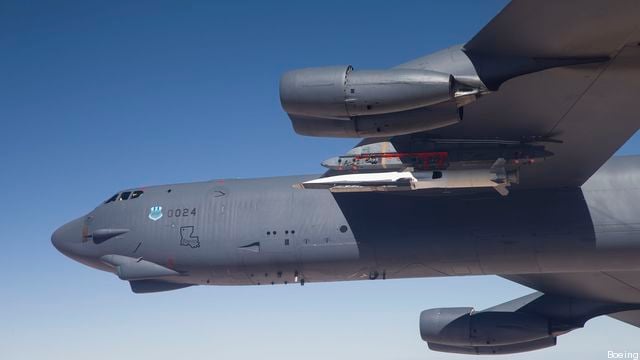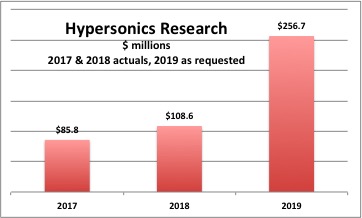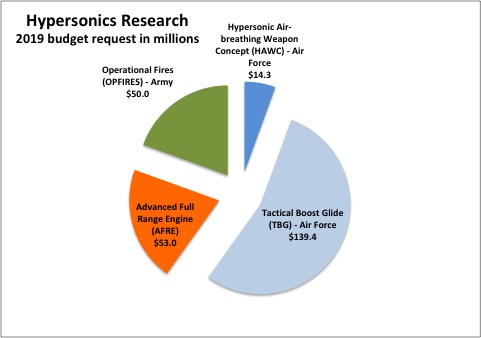DoD Boosts Hypersonics 136 % In 2019: DARPA
Posted on

A B-52 prepares to launch the X-51 “hypersonic” test vehicle.
WASHINGTON: The Pentagon will ramp up research on hypersonic weapons with a stunning 136 percent increase in the 2019 budget request. Here’s the breakdown of the $257 million:
- $139.4 million, the lion’s share, goes to the Air Force-DARPA collaboration on rocket-propelled hypersonics, Tactical Boost Glide (TBG), which will produce an “operational prototype” by 2023;
- $14.3 million goes to Air-Force work on jet-propelled hypersonics, the Hypersonic Air-breathing Weapon Concept (HAWC), which DARPA is hoping the Navy will join.
- $50 million goes to a new joint venture with the Army called Operational Fires (OPFIRES), part of the Army’s new emphasis on long-range artillery and missiles; and
- $53 million goes to the Advanced Full Range Engine (AFRE) for future hypersonic vehicles.
DARPA wanted more money, director Steven Walker said bluntly, particularly to build up an R&D infrastructure currently half the size of China’s. But, he said, this budget is “a good first step.”
Walker ranged widely over DARPA’s portfolio in his breakfast with the Defense Writers’ Group, from artificial intelligence, where he denied the US is falling behind China, to DNA mapping, where he admits China is ahead; to his recent visit to Ukraine, where DARPA is working on some information warfare projects, he said.

SOURCE: DARPA
“This is becoming not just an S&T thing,” said Walker, who’s worked on hypersonics for the last 10 years himself. “The services are engaged and interested in moving forward with real capabilities.”
That service interest is crucial. Historically, promising technologies have often failed to make the transition from Science & Technology on the basics to Research & Development of a working weapon. Transitions between DARPA — famed for out-of-the-box experiments — and the services — which actually build and use the weapons — are particularly tricky.
Getting this transition right is especially important because the U.S. is arguably falling behind China and Russia, which have invested heavily in hypersonics in hopes of rendering U.S. missile defenses obsolete. Moving at Mach 5 or more, a hypersonic weapon would combine the maneuverability and low altitude of a cruise missile with speeds approaching those of a ballistic missile. That makes it a much harder target for interceptors like Patriot, THAAD, or GBI.
Falling Behind?
Vladimir Putin claimed yesterday that Russia had a hypersonic missile already “carrying out…experimental and combat duty” since Dec. 1st. That’s the Mach 10, 1,250-mile-range Kinzhal (dagger), he said, “guaranteed to overcome all existing and I think prospective anti-missile systems.”

Steven Walker
However, China’s much larger economy and talent pool make it a bigger long-term threat. Its DF-17 hypersonic boost-glide vehicle, now in testing, is supposed to enter service around 2020. The Vice-Chairman of the Joint Chiefs, Gen. Paul Selva, has publicly said that China has pulled ahead of the US on hypersonics.
Walker wouldn’t comment on Russia but he did discuss China. “If…you look at the number of facilities they’ve built to do hypersonics, it surpasses anything we have in this country….by two to three (times),” Walker said. “Most of our programs at DARPA are testing in one facility (that’s) doing all it can to work 24-7.”
China has clearly made hypersonics a national priority, Walker said, and last spring DARPA went to then-Deputy Secretary of Defense Bob Work — a noted technophile — to propose a national effort in the US.
“We really tried to convince the department that we need a national initiative in this area,” Walker said. “We did receive a budget increase at DARPA and in some of the services to do more hypersonics. I don’t think we got everything we wanted, but it was good first step.”
At some point, though, “we do need an infusion of dollars in our infrastructure to do hypersonics,” Walker said. “The dollars that were allocated in this budget were great, but they were really focused on adding more flight tests and getting some of our offensive capability further down the line into operational prototypes.”

SOURCE: DARPA
Boost-Glide, Boost-Cruise
Perhaps the most important of those operational prototypes, which Walker says will fly around 2022 or 2023, will be the Air Force’s boost-glide weapon. Such a system uses a rocket motor to accelerate to hypersonic speed, then jettisons the burnt-out rocket and coasts away. Since it’s gliding rather than flying under its own power, a boost-glide vehicle can maneuver but not accelerate.
The alternative approach is a “boost-cruise” vehicle, which also uses a rocket to get up to speed but then switches over to something called a scramjet and flies thereafter on its own power. Like a jet, a scramjet sucks in air from the oxygen to mix with fuel and ignite, providing thrust — but a scramjet only functions at speeds that would tear a regular jet engine apart. It’s a much more complex technology to manufacture than good old-fashioned rockets, which carry their own oxidizer rather than getting it from the air, which means rockets weigh more and have limited range.
DARPA experimented with boost-cruise under the Hypersonic Air-breathing Weapons Concept. The project Walker wants the Navy to join in on is a follow-on to HAWC.
The Army’s OPFIRES system will be a boost-glide vehicle. Walker didn’t say why, but boost-glide technology is simpler and the range is probably adequate for Army targets. Army Chief of Staff Mark Milley has made “long-range precision fires” — modernized cannon, rocket, and missiles– his top modernization priority to counter the massive Chinese and Russian artillery forces.
The difference between the Army and Air Force boost-glide programs? The Army’s will be launched from the ground, the Air Force’s from (you guessed it) the air.
Who will coordinate all these disparate programs? Now that Congress has split the old Acquisition, Technology, and Logistics bureaucracy into two, that responsibility will fall to the first-ever undersecretary of defense for research and engineering, Mike Griffin.
“I’m going to be looking forward to working with the new USD R&E, Mike Griffin, who comes in with an aerospace background, a background at NASA, a background in missile defense,” Walker said. “He understands this problem very well. And I’ve been told by Mike personally that this is going to be …. one of his top priorities.”
Subscribe to our newsletter
Promotions, new products and sales. Directly to your inbox.
